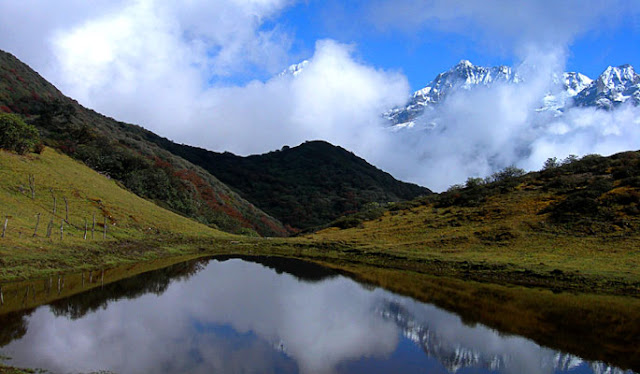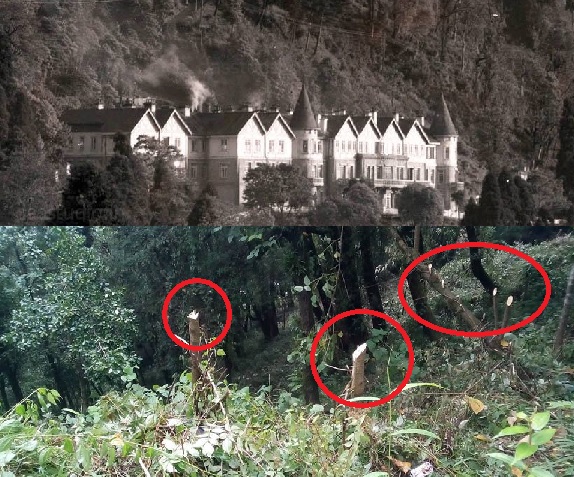Sikkim Gangtok 17th July 2016: Congratulations to The Ministry of Environment and Ministry of Culture, Govt of India and the Govt of Sikkim for successfully ushering in Khangchendzonga (Kanchenjunga) National park as a UNESCO World Heritage Site.
World Heritage Sites fall under three categories: cultural, natural and mixed. These sites are a legacy from the past, what we live with today and what we pass on to future generations as irreplaceable sources of life and inspiration, as stated by UNESCO. Presently there are more than 1,031 World Heritage sites, of which 802 are cultural, 197 natural and 32 mixed. India has 32 sites: 25 cultural and seven natural.
India's two ministries, MoEFCC through its Wildlife Institute and the Ministry of Culture through its World Heritage advisory body proposed, that Khangchendzonga National Park be inscribed under the mixed category.
This category is meant for sites that are an outstanding example of a traditional human settlement living sustainably with ecosystems, with treasure of invaluable traditional knowledge and culture that highlights human interaction with the environment. Such heritage sites have the sort of intangible features that provide an encyclopedia of lessons for vulnerable communities under change of ecosystems. Such lessons are of immense value today when we are faced with the challenge of climate change.
Situated in the eastern Indian state of Sikkim, Khangchendzonga National Park exhibits one of the widest altitudinal ranges of any protected area worldwide and occupies a third of the state's area.
Mount Khangchendzonga and park around are endowed with deep cultural meanings and sacred significance. The multi-layered landscape of Khangchendzonga is sacred to both Buddhists and Lepchas as Mayel Lyang. The expanse represents a unique example of co-existence and exchange between different religious traditions and ethnicities, constituting the base for Sikkimese identity and unity.
The ensemble of sacred texts, the still-performed rituals, the oral history and traditional practices around Mount Khangchendzonga - third highest peak in the world - strengthen human bonds with nature. It conveys and manifests the cultural meanings projected onto natural resources and the indigenous and specific Buddhist cosmogony that developed in the Himalayan region.
The indigenous traditional knowledge of the properties of local plants and the local ecosystem, which is peculiar to local people, is on the verge of disappearing and represents a precious source of information on the healing properties of several endemic plants. The traditional and ritual management system of forests and the natural resources of the land pertaining to Buddhist monasteries express the active dimension of Buddhist cosmogonies and could contribute to the property's effective management.
The participation of Sikkim, which has already shown its extraordinary stewardship by totally converting itself into an organic farming state, in developing the proposal has provided a "bottom-up" approach to the process.
Two international bodies of experts evaluated India's proposal. The International Union for Conservation of Nature assessed the area's natural values and its outstanding universal values. The International Council on Monuments and Sites evaluated the cultural aspects of the nominated property, both visible and invisible.
Both bodies had found undeniable outstanding universal natural and cultural values and clear tangible and intangible authenticity and integrity of the 178,400 hectares of this Himalaya global biodiversity hot spot that has with a buffer zone of some 114,712 hectares.
KNP has now become the second largest World Heritage Site in India after the Western Ghats, which were inscribed in 2012.
Via TheDC
World Heritage Sites fall under three categories: cultural, natural and mixed. These sites are a legacy from the past, what we live with today and what we pass on to future generations as irreplaceable sources of life and inspiration, as stated by UNESCO. Presently there are more than 1,031 World Heritage sites, of which 802 are cultural, 197 natural and 32 mixed. India has 32 sites: 25 cultural and seven natural.
India's two ministries, MoEFCC through its Wildlife Institute and the Ministry of Culture through its World Heritage advisory body proposed, that Khangchendzonga National Park be inscribed under the mixed category.
 |
| UNESCO World Heritage Status for Khangchendzonga/Kanchenjunga National park Sikkim |
This category is meant for sites that are an outstanding example of a traditional human settlement living sustainably with ecosystems, with treasure of invaluable traditional knowledge and culture that highlights human interaction with the environment. Such heritage sites have the sort of intangible features that provide an encyclopedia of lessons for vulnerable communities under change of ecosystems. Such lessons are of immense value today when we are faced with the challenge of climate change.
Situated in the eastern Indian state of Sikkim, Khangchendzonga National Park exhibits one of the widest altitudinal ranges of any protected area worldwide and occupies a third of the state's area.
Mount Khangchendzonga and park around are endowed with deep cultural meanings and sacred significance. The multi-layered landscape of Khangchendzonga is sacred to both Buddhists and Lepchas as Mayel Lyang. The expanse represents a unique example of co-existence and exchange between different religious traditions and ethnicities, constituting the base for Sikkimese identity and unity.
The ensemble of sacred texts, the still-performed rituals, the oral history and traditional practices around Mount Khangchendzonga - third highest peak in the world - strengthen human bonds with nature. It conveys and manifests the cultural meanings projected onto natural resources and the indigenous and specific Buddhist cosmogony that developed in the Himalayan region.
The indigenous traditional knowledge of the properties of local plants and the local ecosystem, which is peculiar to local people, is on the verge of disappearing and represents a precious source of information on the healing properties of several endemic plants. The traditional and ritual management system of forests and the natural resources of the land pertaining to Buddhist monasteries express the active dimension of Buddhist cosmogonies and could contribute to the property's effective management.
The participation of Sikkim, which has already shown its extraordinary stewardship by totally converting itself into an organic farming state, in developing the proposal has provided a "bottom-up" approach to the process.
Two international bodies of experts evaluated India's proposal. The International Union for Conservation of Nature assessed the area's natural values and its outstanding universal values. The International Council on Monuments and Sites evaluated the cultural aspects of the nominated property, both visible and invisible.
Both bodies had found undeniable outstanding universal natural and cultural values and clear tangible and intangible authenticity and integrity of the 178,400 hectares of this Himalaya global biodiversity hot spot that has with a buffer zone of some 114,712 hectares.
KNP has now become the second largest World Heritage Site in India after the Western Ghats, which were inscribed in 2012.
Via TheDC



















.jpg)



